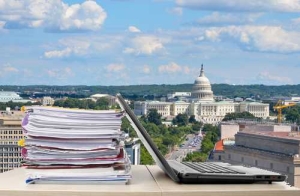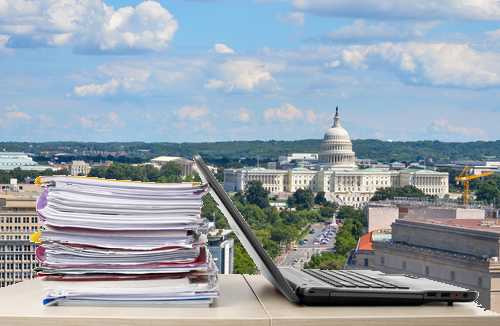A coordinated, intentional program of blended learning is changing teaching and learning in the Nation’s capital.
 For the past two years, the Washington, D.C. Public School District (DCPS) has earned a sort of celebrity status with lawmakers, superintendents, and think tank heads filing in to see what, and especially how, students are learning. They have a good reason to visit. In a district that has been plagued with low test scores and student performance, several D.C. schools have seen student proficiency levels jump in math and reading in recent years.
For the past two years, the Washington, D.C. Public School District (DCPS) has earned a sort of celebrity status with lawmakers, superintendents, and think tank heads filing in to see what, and especially how, students are learning. They have a good reason to visit. In a district that has been plagued with low test scores and student performance, several D.C. schools have seen student proficiency levels jump in math and reading in recent years.
Part of their success has hinged on the way teachers are using blended learning in the classroom.
“Blended learning definitely has been an important factor in the changes we’ve seen in our students, our teachers, and in our schools,” says David Rose, deputy chief in the district’s Dept. of Educational Technology and Library Programs.
In its simplest form, blended learning programs combine face-to-face instruction with personalized online learning using adaptive courseware that gives students some control over their pace and content of instruction.
Next page: How it works in practice
D.C.’s blended learning approach grew out of a district-wide push designed to ratchet up student performance and provide a centralized way to track data from the success of some enterprising schools. That was Spring 2012.
Months of research, careful introspection, and brainstorming led to a reimagined curriculum and classroom structure, with blended learning as a central component. Administrators saw blended learning as a way to provide more personalized, self-directed learning that they could focus on the high-level cognitive skills that students need to succeed in college and beyond.
“We’re not a 1-to-1 district,” says Rose. “We started with academic goals and found the technology to help put those goals in place and to help teachers better reach their students.”
How it works
When done right, blended learning tailors education to each student’s needs by offering high-quality teaching with cutting-edge online learning programs. The district is using two programs, ST-Math and First in Math, for math instruction, and myON and Lexia Learning for English Language Arts and reading in most of its participating elementary schools.
“Blended learning frees up time for project-based learning, higher-order thinking teaching and learning, and Socratic discussions,” says Michael Horn, co-founder and executive director at the Clayton Christensen Institute for Disruptive Innovation. “Teacher time is now freed up to look at other aspects of teaching.”
Next page: Making personalized learning possible
Rose points out that the district incorporated many changes to ensure that it could meet schools Chancellor Kaya Henderson’s five goals as part of her strategic plan to improve D.C. schools. In addition to blended learning, the district renovated and modernized many of its schools to include new infrastructure and wiring, built a few new school buildings, and revamped or refreshed much of its technology.
To get the initiative off the ground, several grants have provided DCPS schools necessary funding, such as a $1 million donation from Microsoft in 2013 to help D.C. teachers redesign classrooms using blended learning and a $2 million Breakthrough Schools grant competition, also in 2013, which awarded six $100,000 planning grants to selected schools. The grant competition was funded in part by the local D.C. CityBridge Foundation, which also funds teaching fellowships.
Randle Heights Elementary School received a $250,000 grant from the Dell Foundation to use explicitly for blended learning. Students spend 10 minutes in whole group discussion and then three 35-minute sessions in small groups either with their teacher, reviewing digital content or doing individual work at learning centers or on projects. They go through this rotation twice a day, even in kindergarten.
In several district schools, where many students are or have been below grade-level, the computer programs help give teachers and students real-time data to monitor academic progress. It has been especially empowering for the students as they now get to see their progress, understand where they are strong and weak, focus on areas to improve and feel a sense of accomplishment when they excel.
“It’s almost like personalized learning because every student’s dashboard looks different based on their learning ability and pace,” said Randle Heights principal Tracy Foster.
For DCPS, it didn’t all happen at once. Across the district, blended learning was rolled out slowly, starting with the most eager teachers, but it caught on as word spread about its success. For some teachers, the move to blended learning has transformed their teaching. Valyncia Hawkins is one of them.
Teaching transformed
Hawkins, a fifth-grade teacher at Anne Beers Elementary School in Southeast D.C., is a 20-year veteran with D.C. schools. She’s also a teaching fellow with the local CityBridge Foundation, which launched a training fellowship program for district teachers to introduce them to innovative ways schools across the U.S. are using technology and blended learning.
Next page: Getting results
“Four years ago, I had no idea” of blended learning, says Hawkins. “But now it’s given me new life as a teacher.”
Hawkins has redesigned her approach to teaching math, having students rotate through stations and spending part of their time learning online and the other part working with her in small groups. She also has designed a summer math program and a website with “playlists” of different activities and assignments students can do on their own and in groups.
“The more I know about blended learning and how to use it, the more I realize I need to learn, but I would rather have it that way,” says Hawkins.
Getting results
While it will be months, or even years, before DCPS schools can point to the long-term effects of using blended learning, administrators here are confident that the program is helping students excel. From 2012 to 2014, Ketcham Elementary School, in Southeast D.C., saw an 11-point increase in its math proficiency rate and a 4.5-point increase in reading. And, over a three-year period, Stanton Elementary School, also in Southeast D.C., doubled its percentage of students proficient in reading while tripling its percentage of students proficient in math.
The district’s goal is to develop a blended learning feeder pattern so students have continued exposure to blended learning throughout their academic career. Currently, students at Randle Highlands and Ketcham will use some form of blended learning throughout their years in the district, since they are the feeder schools to Kramer Middle School and Anacostia High School, both of which have blended-learning programs.
“We’ve seen a real culture shift here and I suspect that we’ll see continued changes and a lot of success as we build up our blended learning program and the content for the students,” Rose says. “It’s a strong move forward.”
Lucille Renwick is a contributing writer for eSchool News.
- TC- What student choice and agency actually looks like - November 15, 2016
- What student choice and agency actually looks like - November 14, 2016
- App of the Week: Science sensor meets your smartphone - November 14, 2016

